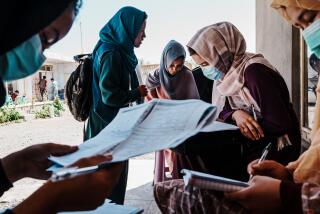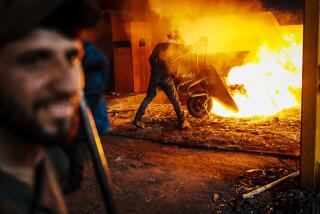Past Provides Lessons for Afghanistan’s Future
- Share via
OMAHA — The few weeks remaining before winter grips Afghanistan could bring the collapse of largely Pushtun Taliban control in much of northern and western Afghanistan. But if history is any predictor, the Taliban’s fall will not come strictly from military losses.
In 1992, entire communist-controlled regions in this same area fell rapidly, as Afghan factions defected en masse to support local, non-Pushtun, moujahedeen. The moujahedeen liberator of Kabul in April 1992 was Northern Alliance Tajik commander Ahmed Shah Masoud. His principal ally was Uzbek Gen. Abdul Rashid Dostum, who had fought under the Soviets and Afghan communists against the moujahedeen for nine years. Dostum’s dramatic defection to Masoud in early 1992 changed the balance of power in the north, dooming the Soviet-supported communist regime in Kabul. Dostum is back today, opposing the Taliban and directing the anti-Taliban assault against Mazar-i-Sharif, the largest city in northern Afghanistan.
If 1992 is any precedent, anti-Taliban forces (dominated by members of the Tajik, Uzbek and Hazara ethnic groups) will again sweep through the non-Pushtun northern regions, assisted by U.S. air strikes and special forces. The first province--Ghor--fell to the moujahedeen commander Ismail Khan on Oct. 11. Mazar-i-Sharif, despite a recent setback, is likely to be next. Herat, located near the Iranian border, Tolaqan and Konduz will eventually all slip from Taliban control. The Northern Alliance and Hazara forces from the west could be positioned to occupy Kabul as early as the end of the year.
The entire Taliban leadership, however, is Pushtun, as is approximately 40% of Afghanistan’s population. Victory for the international coalition attempting to uproot the Muslim extremist network in Afghanistan will not be assured unless the anti-Taliban wind also sweeps through the Pushtun areas south of Kabul.
This won’t be easy. One possible scenario is that the Taliban will abandon Kabul and fall back to Kandahar in the Pushtun heartland. Pro-Taliban Pakistani religious parties, and perhaps factions in the Pakistani military, may prolong the Taliban’s staying power in Afghanistan’s southern Pushtun belt. Demonstrations organized by Pakistan’s “jihadi” parties would continue unabated in northern Pakistan’s Pushtun areas, attracting Pakistani recruits to join the Taliban and Al Qaeda forces inside Afghanistan. The current cooperative stance of the Pakistani leadership might begin to erode, as powerful pro-Pushtun constituencies in Pakistan’s political-military-religious establishment consider ways to resist non-Pushtun control of Afghanistan. Should something like this scenario emerge, the U.S. assault on the international extremist Muslim network in Afghanistan could last well into next year or longer.
Another unpleasant possibility is that regardless of who takes control in the short run, the situation will ultimately devolve into a fresh, post-Taliban war in Afghanistan with Pushtuns against non-Pushtuns. Pakistan’s current efforts to resurrect a reformed Taliban cannot succeed. Russia, India and Iran would support non-Pushtuns in resisting a Pakistani sponsored warmed-over Taliban. Efforts by the international community and many Afghans to create a broadbased post-Taliban Afghan political consensus may flag. Radical Muslim enclaves in southern Afghanistan may well continue to promote international terrorism. If all this were to happen, it would be not merely the future of Afghanistan as a nation-state in jeopardy: Ripples of instability and militant Islam could well spread into South and Central Asia, western China and the Middle East.
To prevent this scenario, it is essential that the U.S.--along with Pakistan, Afghanistan’s other neighbors and the international community--not be seen as favoring any one Afghan faction. Speculation by foreign leaders over which Afghan factions should be included in the post-Taliban Afghan regime is destructive to a successful intra-Afghan political settlement. Northern anti-Taliban forces must resist the temptation to seize Kabul, deferring instead to a U.N.-assisted arrangement to manage Afghanistan’s capital. The U.N. could then help the different Afghan groups organize a broad-based Afghan act of self-determination presided over by former Afghan monarch Mohammad Zaher Shah. It will be incumbent on the Afghans to persuade Pakistan that the post-Taliban Afghan government will pursue friendly relations with Islamabad.
American strategy should emphasize political and psychological prongs geared to mobilize rather than dampen widespread anti-Taliban sentiment among both Pushtun and non-Pushtun Afghans. U.S. military and covert intelligence tactics must become better coordinated in order not to undermine this strategic goal. U.S. airstrikes should concentrate on targets away from Afghanistan’s cities and towns so as not to unite Afghan citizens behind the Taliban in opposition to the bombing. U.S. Special Forces should be deployed primarily to assist anti-Taliban Afghan Muslim forces move against remaining Taliban and Al Qaeda enclaves. We should immediately begin positioning massive amounts of food and other humanitarian assistance for distribution in Afghanistan--and not just in the north, but in the Pushtun south as well. U.S. military strikes should be suspended during Ramadan, replaced by massive aid convoys to demonstrate to the Afghan people that we are opposed to their government, not to them.
During the Soviet-Afghan war, the U.S. was seen by many within Afghanistan as assisting Afghans to liberate their country. It is important that America revive this posture, this time helping Afghanistan to eliminate the foreign-imposed Muslim extremist network inside Afghanistan. Al Qaeda and its radical Arabs and Pakistani allies are maneuvering to counter this interpretation of events, casting U.S. military actions as an assault on Afghanistan itself. Herein lays the principal threat to U.S. success, in particular among the 10 million Pushtuns in southern Afghanistan and their Pushtun allies across the border in Pakistan.
U.S. experience in Afghanistan over the last two decades clearly warns against, once again, inadvertently sowing the seeds for a next Afghan conflict. With American help, it is likely the Afghans will be able to eliminate the alien Muslim extremist network operating within its borders. But it is essential that this anti-Taliban wind blow not just through the non-Pushtun north, but through Pushtun-dominated southern Afghanistan as well. To preserve the victory over the longer run, U.S. diplomacy can creatively press for a U.N.-sponsored international conference to revive Afghanistan’s classic buffer status between contending powers in Central Asia.
The 1955 Austrian state treaty offers a model for restraint among the world powers that could easily be applied to this proud, independent nation. In that international accord, the U.S., its allies and the Soviet Union agreed to withdraw their occupation forces from Austria, vowed to respect Austria’s neutrality and, in effect, pledged not to attempt to extend their spheres of influence into the Austrian buffer zone. For the remainder of the Cold War, Austria remained an island of peace and neutrality in Central Europe. Afghanistan deserves nothing less.
More to Read
Sign up for Essential California
The most important California stories and recommendations in your inbox every morning.
You may occasionally receive promotional content from the Los Angeles Times.













